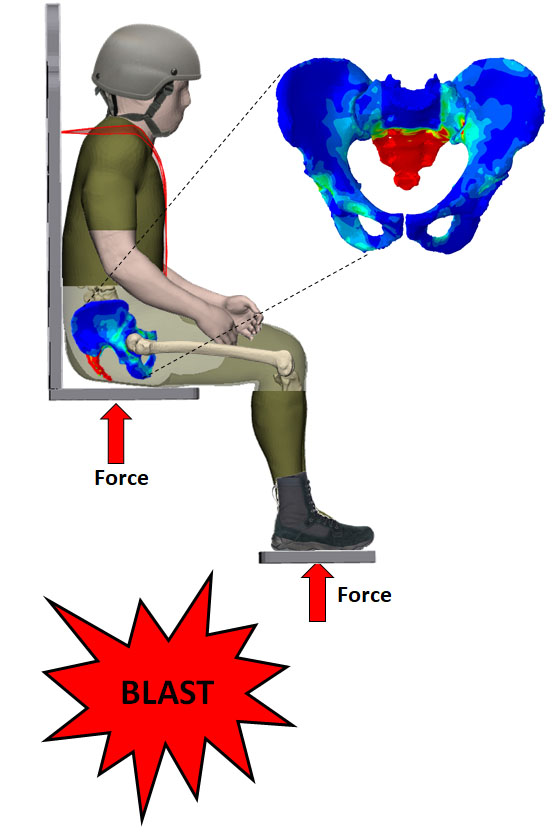Minimising severe injury from blast events on military vehicles
Blast events inflicted on military vehicles are a consistent threat in contemporary conflicts. Developing equipment that better protects soldiers from this threat has become the focus of significant military research.
It is critical to understand how severe injuries are inflicted and how forces from blast events are transmitted to the human body in order to strengthen blast protection for soldiers. Biomechanics researchers at the University of Melbourne, in collaboration with the Defence Science and Technology Group (DST), have developed simulations to replicate the extreme loads placed on the human body during a vehicle-based blast event. These models will be the key to unlocking the mystery of injury mechanisms and will inform decisions on vehicle design in future.

A mine or Improvised Explosive Device (IED) attacking an armoured vehicle generates a blast wave causing substantial underbelly damage to the vehicle and trauma to its crew. Traumatic injury can occur even when a vehicle retains structural integrity. The criteria for predicting injuries is traditionally derived from aircraft or car crash scenarios, which have limitations when describing the vertical loading directions for underbelly blasts. The research looks to address this knowledge gap by providing important data on the injury risk from blast events.
The spine and pelvis were a key focus in this work. Spinal cord injury and pelvic fractures are of major concern, as they are often fatal or cause life-long disability. Dr Dale Robinson, a researcher in Biomedical Engineering, developed a specialised loading system that subjected human tissue to the extreme accelerations of a blast event; critical for understanding injury initiation and progression.
“This information is not exclusive to military applications, but it provides insights to injury prevention across other trauma areas such as falls or sporting accidents,” says Dr Robinson.
In these experiments, Dr Robinson pioneered an acoustic system specialized in detecting the minute sounds of bone injury as it happens, providing unique insight into the fracture process.
“This acoustic system gives us is the ability to track a bone injury from its initial microfracture to the point where the bone is fully broken. This information tells us precisely what load initiated the fracture and may reveal insights into why certain microfractures did not progress to a serious injury.”
Whilst it is obvious that a spinal fracture poses a significant risk for spinal cord injury, the research showed that in such an extreme loading environment, spinal cord injuries can occur without a spinal fracture.
“The findings show that risk of spinal cord injury occurs at lower forces than previously thought. This is important to consider when identifying spinal cord injury using computed tomography (CT) imaging, since this technique would overlook such injuries if there was no spinal fracture.”
 Considering the pelvis is the predominate skeletal structure contacting the seat in a military vehicle, fractures are likely to be sensitive to position, which can vary due to an individual’s seated posture. To evaluate this sensitivity, specialised computer models were developed to simulate impact loading to the pelvis resulting from an underbelly blast.
Considering the pelvis is the predominate skeletal structure contacting the seat in a military vehicle, fractures are likely to be sensitive to position, which can vary due to an individual’s seated posture. To evaluate this sensitivity, specialised computer models were developed to simulate impact loading to the pelvis resulting from an underbelly blast.
“This type of computer model offers us a cost-effective alternative to experiments; once the model is proven, it allows us to explore the effects of a diverse number of variables which are not feasible experimentally. We found that pelvic fractures are more likely to occur when an individual is seated more upright than if they are flexed forward. If the solider is slouched, they are more likely to sustain lower spinal fractures, presenting a lesser risk of fatality than pelvic fractures,” says Dr Kwong Ming Tse, a researcher in computational biomechanics who built the models and simulated the dynamic events.
Dr Melanie Franklyn, a DST researcher who developed this project in conjunction with the University of Melbourne, said that the results of the work were critical to better understand the tolerance of the pelvis and lumbar spine to vertical impact loading. She suggests the research could be applied to the development of improved energy-attenuating seats for mitigating serious injuries.
Data from the research has also been shared with the US-led WIAMan (Warrior Injury Assessment Manikin) Project Team. The team is developing a new Anthropomorphic Test Device (ATD) for blast testing – the first dummy specifically designed for vertical impact loading.
“Our study has led to new criteria where researchers can now confidently assess the likelihood and severity of spine and pelvis injuries resulting from underbelly blast,”says project lead, Professor Peter Lee.
This milestone research development will improve the accuracy of risk assessment for injury by Defence personnel developing equipment. Knowledge regarding injury sensitivity will also inform Defence and the general public of risk factors and improved identification related to traumatic injuries; particularly those specific to the spinal cord and pelvis.